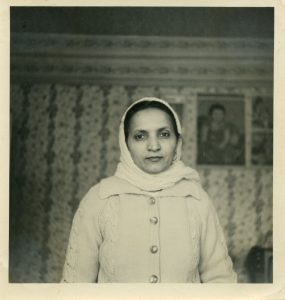The UK of the 1960s was a vastly different place where racism and xenophobia were deeply ingrained, and unlikely to be challenged like present time, presenting immense challenges for the first waves of South Asian immigrants. Amidst this landscape, an 11-year-old Akbal Singh Kang arrived in Bradford from Punjab, India, in 1961. Defying the prejudices of the time, he went on to excel in academia and textiles while simultaneously creating a stunning photographic archive—one that documents the struggles, triumphs, and cultural transformation of South Asian migrants during a period of profound social change.

Now, his legacy is being preserved and showcased in the exhibition “4000 Miles to Home”, curated by his son, Gurjinder Kang. Previously displayed at Bradford Civic Society and the National Media Museum, the exhibition is now accessible online, offering a rare and deeply personal insight into the migrant experience of the 1960s and 1970s.
A Social Documentary from Within
For Gurjinder, the significance of his father’s work lies in its authenticity—a firsthand narrative told from inside the community, rather than an external, often biased perspective.
“Most Commonwealth migration stories are told from the British viewpoint. My father’s work, however, offers a raw and intimate glimpse into the realities of daily life—family bonds, traditions, struggles, and resilience—all captured in an unfiltered and deeply moving way.”
The collection not only preserves the cultural evolution of Punjabi Sikh migrants but also highlights a crucial moment when many decided to lay down permanent roots in the UK rather than return to India.
“It captures that pivotal moment when they stopped being visitors and started being settlers—when they realised that their future was here.”
The Journey of a Pioneering Generation
The decision to stay was not an easy one. Language barriers, cultural differences, lack of legal representation, and widespread discrimination made everyday life an uphill battle.
“They arrived with little knowledge of the language, no financial safety net, and no idea how British society worked. Yet they persevered. They took risks, they worked hard, and they refused to be defeated. That’s what makes their story so inspiring.”
Akbal’s photographs document this perseverance—capturing the grit, determination, and sacrifices of a generation that paved the way for the South Asian communities thriving in the UK today.
A Son’s Journey to Rediscover His Father’s Work
While Gurjinder always knew of his father’s photographic archive, it wasn’t until he delved

deeper that he realised the full scale and significance of what had been captured.
“Looking through his work was like unlocking a treasure trove of history. I was uncovering a story of absolute perseverance and fearlessness—not just of my father, but of an entire community.”
Beyond photography, Akbal was also politically active, advocating for equal rights and representation for Sikhs in the UK workplace.
“The Sikh ethos is one of equality and community. My father and his peers pushed for better representation in employment and fought for the rights that we now take for granted.”
The Intersection of Art and Politics
For Akbal, photography was more than just a passion—it was a form of activism. His work captures not only personal moments but also public movements that sought to ensure future generations would not face the same struggles.
“Art and politics have always been intertwined. Through his lens, my father documented the fight for inclusion—highlighting the voices and faces that refused to be ignored.”
Documenting the Youth Movement
A particularly striking aspect of the exhibition is its focus on young people. The photographs showcase the dual identities of British-born Sikh youth—balancing Punjabi heritage with the reality of growing up in 1970s Britain.
“It reflects the progressive ideals of the younger generation—children of immigrants who were beginning to find their own voice and place in British society.”

A Groundbreaking Achievement in British Education
Beyond his artistic and political contributions, Akbal made history by becoming the first non-white Head Boy in England at Fairfax School, Bradford—a milestone that signified real progress in a time of exclusion and discrimination.
“It was an incredible achievement given the racial tensions of the time. My father knew what it meant—not just for him, but for others like him. It was a sign that change was possible.”
Many highly educated and skilled immigrants struggled to secure even basic jobs due to discrimination. Akbal’s success was a beacon of hope for future generations.
A Photographer’s Mission
So, what drove Akbal to document this era so meticulously? According to Gurjinder, it was an instinctive need to tell a story—not just of hardship, but of resilience and ambition.
“He wanted to show the spirit of the people—how they built their lives from nothing, how

they held onto their identity while forging a new future. He was capturing not just a moment, but a movement.”
A Lasting Legacy
Akbal’s legacy is twofold: an expert in textiles and technology, and a documentarian of an untold history. His work offers a concrete, irreplaceable record of the struggles and successes of South Asian migrants, ensuring their stories are never forgotten.
“His work tells us: ‘I have value, I have worth, and I belong here.’ That’s the message he wanted to leave behind.”
With previous exhibitions at Bradford Civic Society and the National Media Museum, and future showcases in the works, Akbal’s story continues to inspire.
Through his lens, Akbal Singh Kang captured a generation’s journey—a journey of resilience, hope, and belonging.
You can explore the exhibition online, by visiting: Bradford Civic Society




